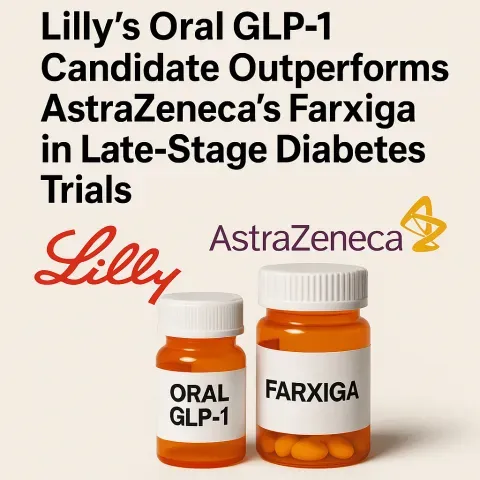
SHERIDAN, WYOMING – October 15, 2025 – Eli Lilly’s investigational oral GLP-1 receptor agonist, orforglipron, has achieved another major milestone in its late-stage clinical program. Following its earlier success against Novo Nordisk’s semaglutide, the once-daily oral therapy has now demonstrated superiority over AstraZeneca’s blockbuster Farxiga (dapagliflozin) in two Phase III studies targeting patients with inadequately controlled type 2 diabetes.
Strong Phase III Results Reinforce Competitive Edge
The twin trials, ACHIEVE-2 and ACHIEVE-5, assessed orforglipron’s efficacy and safety in patients whose diabetes remained poorly controlled despite metformin therapy. Both studies met their primary and secondary endpoints, showing significant improvements in key glycemic markers and body weight after 40 weeks of treatment.
- A1C reduction: 1.7% with the highest dose of orforglipron versus 0.8% with Farxiga in ACHIEVE-2
- Weight loss: consistent, clinically meaningful reduction across cohorts
- Cardiometabolic benefits: improvements in cardiovascular risk factors, aligning with Lilly’s earlier findings
Lilly reported that tolerability mirrored prior studies, with gastrointestinal events being the most frequent but typically mild or moderate. Importantly, no liver safety issues emerged — a common concern among other oral GLP-1 drug candidates.
Quote from Lilly Leadership
Jeff Emmick, Senior Vice President of Product Development at Lilly Cardiometabolic Health, stated:
“Together, these results reinforce orforglipron’s potential to become a new standard of care for people living with type 2 diabetes.”
Rising Competition in the Oral GLP-1 Arena
The diabetes and obesity market has become one of the most competitive pharmaceutical battlegrounds, with GLP-1 therapies driving much of the momentum. AstraZeneca’s Farxiga generated $7.7 billion in 2024, reflecting its entrenched market position in both cardiovascular and glycemic management. Lilly’s head-to-head data positions orforglipron as a serious oral contender capable of reshaping prescribing behavior.
Lilly’s earlier ACHIEVE-3 study had already demonstrated superiority over oral semaglutide, showing a 2.2% A1C reduction compared to 1.4% and 9.2% average weight loss versus 5.3% after 52 weeks. These consistent results suggest broad potential for the molecule across metabolic and obesity indications.
Strategic Pipeline Positioning and Market Implications
Orforglipron is part of a broader GLP-1 and dual-agonist strategy at Lilly, which also includes tirzepatide (marketed as Zepbound for weight loss and Mounjaro for diabetes). The company continues to conduct head-to-head trials against Novo Nordisk’s Wegovy and Ozempic, aiming to capture additional share in the fast-expanding metabolic disease sector.
Industry analysts note that Lilly’s approach — direct comparative studies rather than placebo-only designs — provides a more compelling case for payers and clinicians seeking real-world differentiation.
What Comes Next for ACHIEVE and GLP-1 Competition
Lilly plans to present full ACHIEVE-2 and ACHIEVE-5 data at an upcoming medical meeting, with ACHIEVE-4 — comparing orforglipron to insulin glargine in high-risk, overweight, or obese patients — expected to conclude in early 2026. The final dataset will clarify whether Lilly’s oral GLP-1 can match or exceed injectable standards in both metabolic control and cardiovascular protection.
Strategic Outlook for Healthcare Providers
For endocrinologists and primary-care physicians, the availability of an oral GLP-1 with strong efficacy and a favorable safety profile could expand treatment adoption among patients reluctant to use injectables. Should regulatory approvals follow, orforglipron could enable:
- Simplified treatment pathways for type 2 diabetes management
- Broader patient adherence due to oral convenience
- Potential early combination use with SGLT2 inhibitors or insulin therapies
As the GLP-1 landscape evolves, Lilly’s data momentum underscores a decisive move toward oral-based metabolic solutions that may redefine future standards of care.
Learn more at www.lilly.com.